Contact Dyeing In a recent class at the School of the Art Institute of Chicago, "A Study in Natural Dyes," we were challenged to contact-dye fabric using three common foodstuffs found in our kitchens, using sunlight as the primary heat source. Our starting point was the article "In the bag: Contact Natural Dyes", by Sara J. Kadolph and Karen Diadick Casselman (Clothing and Textiles Research Journal, Volume 22, Numbers 1/2, pp. 15-12, 2004) In order to experiment with as many different techniques and types of materials as possible, I chose fruit juice, powdered spice, and fresh plant leaves—pomegranate juice, turmeric and flat-leaf parsley. All are readily available, and each requires a different fabric manipulation technique. Each 10 inch square of white cotton fabric was treated with liquid scour at 5.5% and soda ash at 2% weight of fiber, dissolved in tap water. The dye-pot temperature was brought up to 180 degrees, and held for 30 minutes. Then the fabric was mordanted with alum acetate at 5% weight of fiber, brought up to 100 degrees and held for one hour. The fabric was refrigerated, moist and un-rinsed, for a few days. The piece to be dyed with pomegranate juice was air-dried and then shirred by running it through with rows of stitches which were pulled tight and tied. The fabric was then re-moistened. Two cups of bottled pomegranate juice were boiled down until one cup remained. The wet fabric was placed in a plastic bag, the hot juice poured in, and the bag sealed. To dye with tumeric, I made a dry paste of ½ tablespoon turmeric and 1 tablespoon hot water. Small balls of this paste were then placed on the second piece of fabric, the fabric gathered around it, and each bundle tied with dental floss. I made about twelve little bundles in all. This fabric was sealed in a plastic bag. Then the two plastic bags were taped to a window where they would receive the afternoon sun, such as it is in Chicago in late October! The flat-leaf parsley required more extensive treatment. The parsley stalks were washed and then arranged on the fabric. When I crushed a leaf of parsley in my fingers, a vibrant green paste resulted, and my hope was that I could create a "transfer" of the entire parsley plant on the mordanted fabric. After the stalks of parsley were arranged on the fabric, it was carefully placed flat inside a plastic bag and sealed. This was placed on a table in front of the window, and then rolled with a full bottle of sherry. Of course, a rolling pin would have worked as well, but I didn't have one, so I improvised, rolling the bottle back and forth across the fabric until I felt the plant was well crushed, judging by the sound. Then I covered it with a heavy glass baking dish, and filled the dish with boiling water, using a clear glass dish so the sunlight could reach the fabric. The cooled water was replaced with boiling water each morning and evening. I rolled the bag with the bottle two additional times over the next few days to extract as much pigment as possible. After a not-very sunny week, the three pieces of fabric were removed from the bags and air-dried for a few days, then washed. The results were not exactly what I had anticipated, but nevertheless delightful. The pomegranate juice yielded a warm tan, with hints of red. The resist from the shirring was barely visible, probably due to two factors—the stitches were too large and far apart, and more importantly, the week-long soaking time allowed the dye to penetrate the fibers thoroughly and evenly, despite the stitching. The parsley did not "transfer" to the fabric clearly, but instead diffused a pale yellow-green across the fabric, with the shape of the plant faintly discernable. The turmeric bundles, when unbound and washed thoroughly, yielded bright yellow sunbursts scattered across the fabric. Upon close examination, they look as if the fabric has been printed with yellow flowers. I consider this class assignment a complete success, not because the results were exactly as anticipated, but because it combined the creative essentials: experimenting and gaining an understanding about material properties, combined with a sense of serendipity. The fabric swatches were surprising and beautiful, and now I can never walk through the grocery store without thinking, "Hmm, what color or pattern might that give me?"
By Laurie McGregor Carroll
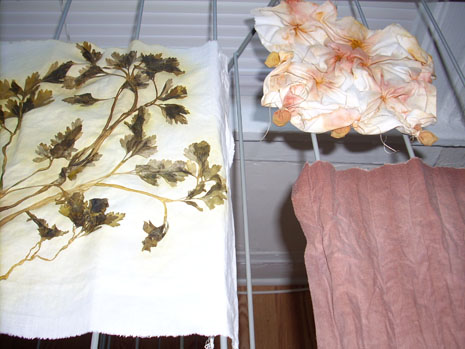
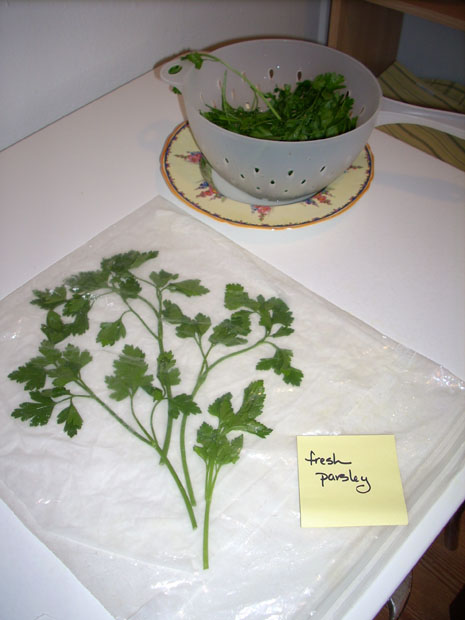
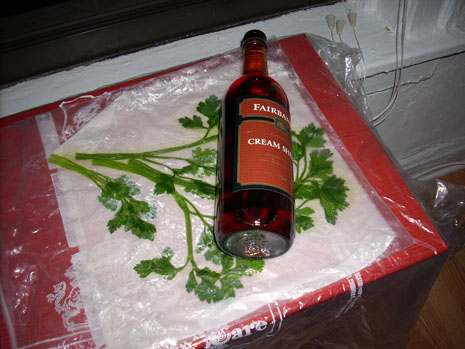
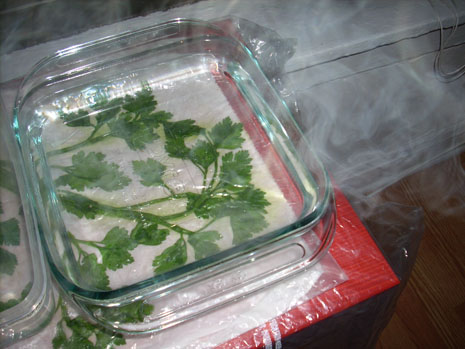
 Turkey Red Journal
Turkey Red Journal

| Volume 14 Issue 2 | A Journal Dedicated to Natural Dyes | Spring 2009 |
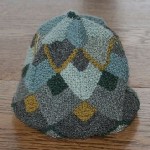
Knit hat dyed with fresh leaf indigo.
Photograph Copyright by Ruth Cadoret
In this Issue
Articles:
• A Scottish Colour Kitchen
• Earth's Palette: Natural
Colors for Fiber
• How Natural is Natural?
Notes from ISEND 2008
• International Shibori
Symposium 2008
• Returning To Art
• Book Review:
Judith H. Hofenk de
Graaff, The Colourful
Past: Origins, Chemistry
and Identification of
Natural Dyestuffs
Nature's Gallery:
• Diana Maher and
Patricia MacIndoe
Drying the fabric after dyeing
Photograph Copyright by Lauri Carroll
Turmeric bundles in fabric
Photograph Copyright by Lauri Carroll
Parsley placed on fabric
Photograph Copyright by Lauri Carroll
Rolling parsley into fabric
Photograph Copyright by Lauri Carroll
Boiling water-press on parsley
Photograph Copyright by Lauri Carroll